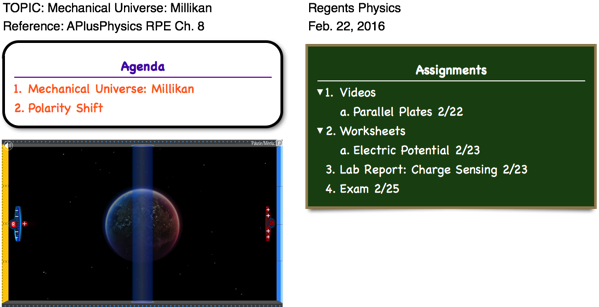
Tag Archives: electron
Charge Sensing Lab
Introduction
 The work electricity comes from the Greek word elektron, which means "amber." Amber is a petrified tree resin, and the ancient Greeks understand that if you rub an amber rod with a piece of cloth, the amber attracts small pieces of leaves or dust. A piece of hard rubber, a glass rod, or a plastic ruler rubbed with a cloth can also display this "amber effect," which we know as static electricity.
The work electricity comes from the Greek word elektron, which means "amber." Amber is a petrified tree resin, and the ancient Greeks understand that if you rub an amber rod with a piece of cloth, the amber attracts small pieces of leaves or dust. A piece of hard rubber, a glass rod, or a plastic ruler rubbed with a cloth can also display this "amber effect," which we know as static electricity.
Two types of electric charge exist, as determined by Benjamin Franklin in the 1700s. Franklin labeled these charges "positive" and "negative." He also found that the charges either attract each other, or repel each other. Detailed experiments showed that unlike charges attract, and like charges repel.
Franklin also determined that, in generating any amount of charge, the amount of charge generated on the rod was equal to the amount of opposite charge generated by the cloth. Stated more clearly in the law of conservation of electric charge: "the net amount of electric charge produced in any process is zero."
Precautions in Using the Charge Sensor
Modern synthetic shoes, fabrics, and plastic insulators readily accumulate stray static charges under moderately dry conditions, so care must be taken that the charges measured are those in the experiment, not those on the experimenter. Three simple precautions help:
- Experiments should be performed on a lab table with a square of heavy-duty aluminum foil connected to the grounding (black) lead of the sensor. Folding the edges under 1 cm keeps the clip from tearing the foil.
- Use a metal can as the conducting sensor body, insulated from the ground plane by an empty inverted glass jar or beaker.
- The experimenter should be connected by a grounding lead to the foil ground plane by a grounding bracelet or a strip of heavy-duty foil, folded over four times, wrapped around one wrist, and connected to the ground plane with a long clip lead.
Experimental Setup
- Begin by setting up your experimental apparatus as shown. Place a square of aluminum foil on your lab table, and connect it to the ground (black) lead of your charge sensor. Place your metal sensing can on top of a glass jar on the aluminum foil, and connect the sensing (red) lead of the charge sensor to the can. Verify the charge sensor is set to +/- 10V. Press and hold the reset button the charge sensor to drain the capacitor.
- Connect the charge sensor to the LabPro using the Analog1 input. Start up LoggerPro software and verify that the software is reading charge. Again reset the charge sensor.
- Create a grounding strap for the experimenter by folding a thin piece of aluminum foil over 4 times and wrapping it around your wrist. Connect this strap to the grounded aluminum foil square using a long clip lead.

Detecting Charge by Induction
- Begin measurements by grounding the sensor and discharging the internal capacitor with the zero button. As you move through each step, record your observations.
- Rub a plastic straw or amber rod with a small square of paper towel, fur, or wool. Bring the straw or rod near the can and observe the reading.
- Observe the charge reading as you slowly lower the charged end of the straw or rod into the can.
- Rub the straw or rod lightly with your fingers to neutralize its charge and bring it near the can to check. Rub it with the fur or cloth and drop the fur or cloth immediately into the can and observe the effect.
- Experiment and determine what combination of materials gives you the most negative charge. What were the materials and what was that negative charge?
- What combination of materials gives you the most positive charge? What were the materials and what was that positive charge?
- Zero your system. Rub the plastic straw with a cloth and drop it into the can. What is the charge on the can? Now quickly drop in the cloth. Now what is the charge on the can? What does this say about the law of conservation of electric charge? Where might any error or stray charge have been lost or gained?
- Search the internet for "charging by induction." Using what you learned doing the experiment and what you read, write a summary paragraph explaining what charging by induction means.
Analyzing the Electroscope
- Obtain an electroscope and neutralize it. Explain how you neutralized the electroscope.
- Create a negative charge on a straw or rod. Bring the rod near the electroscope. Record what happens. Explain why the electroscope behaves as it does.
- Move the rod away from the electroscope. Record what happens. Explain why the electroscope behaves as it does.
- Move the rod back to the electroscope again, this time touching the rod to the contact on the electroscope. What happens? Now what happens when you move the rod away? Why?
Experiments with Charged Tape
- Charge two pieces of transparent tape oppositely by stikcing the sticky side of one to the slide side of the other. Draw them lightly between your fingers to neutralize stray charge, then bring them near the can to check for neutrality.
- Separate the pieces of tape and observe what happens when you bring them near each other.
- Observe the charge readings as you bring each one near the can. Note the effect of distance as you move a piece of tape closer to the can and the competing effect of the two pieces of tape as you move them closer to and farther from the can. Record and explain your observations.
- Drop a piece of charged tape into the can without touching the can yourself. Compare the reading with the charged tape in the can to the maximum reading as you brought it closer to the can.
- Drop the oppositely charged tape in the can. If you have handled them carefully, the charges should nearly cancel.
- Charge different lengths of tape and determine the charge per unit length (in nC per cm). Record your observations and data.
Deliverables
Carefully answer all questions and requests proposed in this lab report on a separate sheet of paper with your name and period at the top. Each class member must turn in their own paper. This will require you to read the entire set of directions in detail.
Your paper should have three sections:
- Detecting Charge by Induction
- Analyzing the Electroscope
- Experiments with Charged Tape
Place your neatly completed sheet in the Inbox.
